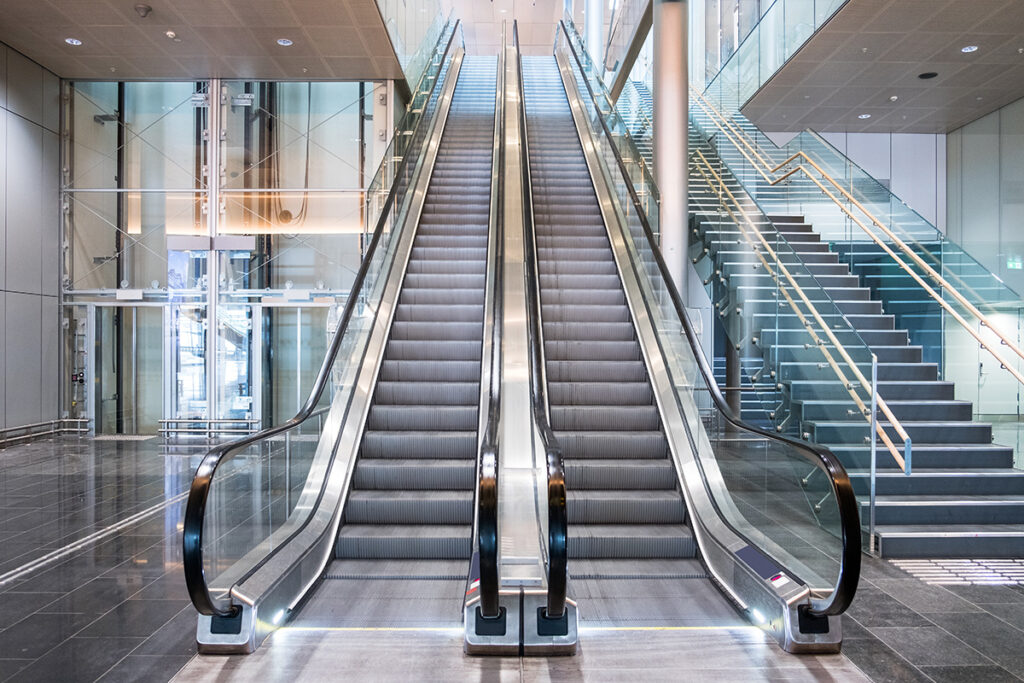Reliable Escalators
Engineered For Safety And Performance
Escalators are a ubiquitous feature in modern urban environments, facilitating the vertical movement of people within various public spaces such as shopping malls, airports, train stations, and office buildings. These inclined moving walkways consist of a series of steps or treads that continuously circulate in an endless loop, transporting passengers effortlessly between different levels. This technical content delves into the design, construction, operation, and safety features of escalators.

The process
Design and Construction
Step Configuration
Escalators typically consist of a set of alternating steps arranged in a continuous loop. The steps are made of sturdy materials such as metal or reinforced plastic and are designed to withstand heavy loads and constant use.
Incline Angle
The incline angle of an escalator is carefully engineered to provide efficient vertical transportation while ensuring passenger comfort and safety. The angle of inclination typically ranges between 30 to 35 degrees, although this can vary depending on the specific design requirements and space constraints of the installation site.
Drive System
Escalators are propelled by a sophisticated drive system located beneath the steps. This system typically consists of a motor, gearbox, and drive chains or belts that power the movement of the steps. Modern escalators often employ energy-efficient variable frequency drives (VFDs) to control the speed and acceleration of the escalator, optimizing energy consumption and reducing operational costs.
The process
Safety Features
Skirt Brushes
Located along the sides of the escalator, skirt brushes prevent debris and loose clothing from becoming trapped in the moving parts, enhancing passenger safety.
Safety Sensors
Escalators are equipped with a variety of sensors, including infrared sensors and pressure-sensitive devices, that detect obstructions and automatically stop the escalator to prevent accidents.
Emergency Stop Buttons
Strategically located at various points along the escalator, emergency stop buttons allow passengers to halt the escalator in the event of an emergency or malfunction.
The process
Operation and Maintenance
Routine Inspections
Escalators require regular inspections and maintenance to ensure optimal performance and safety. Maintenance tasks typically include lubricating moving parts, inspecting safety devices, and checking for signs of wear and tear.
Remote Monitoring
Many modern escalators are equipped with remote monitoring systems that allow operators to remotely monitor the escalator's performance, diagnose issues, and schedule maintenance tasks proactively.
Scheduled Maintenance
Escalators undergo scheduled maintenance at regular intervals, during which technicians inspect and service critical components such as the motor, drive chains, and braking system.
Reliable Travelator
Travelator
Travelators, also known as moving walkways or horizontal escalators, are mechanized conveyor systems designed to transport passengers horizontally or on a slight incline over short to medium distances within transportation hubs, airports, shopping centers, and other public spaces. This technical content explores the design, construction, operation, and safety features of travelators.

The process
Design and Construction
Belt Configuration
Unlike escalators, travelators consist of a continuous belt or series of interlinked belts that move along a track. The belt surface is typically made of durable materials such as rubber or steel to withstand heavy foot traffic and rolling luggage.
Length and Width
Travelators vary in length and width depending on the intended application and passenger throughput. Standard widths range from 800 millimeters to 1,200 millimeters, while lengths can extend from a few meters to over a hundred meters to accommodate varying travel distances.
Incline Angle
Travelators can operate on a level surface or a slight incline to facilitate passenger movement over short distances. The incline angle, if present, is usually minimal, ensuring ease of use and accessibility for passengers of all ages and abilities.
The process
Operation and Safety Features
Safety Sensors
Travelators are equipped with a range of safety sensors, including pressure-sensitive devices and infrared sensors, to detect the presence of passengers and objects on the belt. These sensors trigger automatic stop mechanisms to prevent accidents and ensure passenger safety.
Emergency Stop Buttons
Emergency stop buttons are strategically located along the length of the travelator to allow passengers to halt the movement of the belt in case of an emergency or malfunction.
Handrail and Guardrails
Travelators feature handrails along the sides of the belt to provide stability and support for passengers. Additionally, guardrails are installed along the edges of the travelator to prevent passengers from accidentally stepping off the moving belt.
The process
Maintenance and Inspection
Regular Maintenance
Travelators require routine maintenance to ensure optimal performance and safety. This includes lubricating moving parts, inspecting the belt for signs of wear and tear, and checking the alignment of the belt and track.
Remote Monitoring
Many modern travelators are equipped with remote monitoring systems that allow operators to monitor the status and performance of the equipment remotely. This enables proactive maintenance and minimizes downtime due to unexpected failures.
Conclusion
Travelators are indispensable components of modern transportation infrastructure, providing efficient and convenient horizontal transportation for passengers in various public spaces

